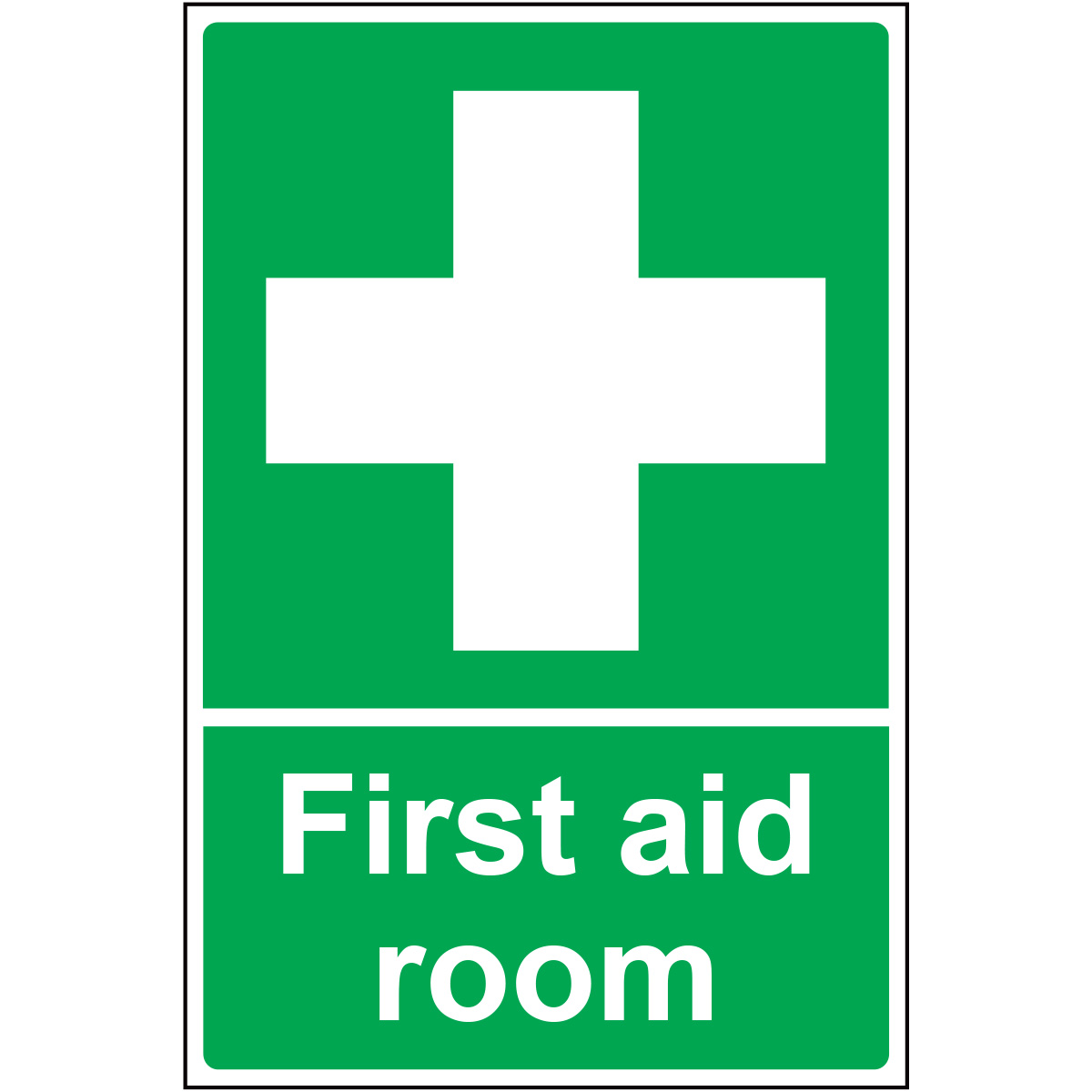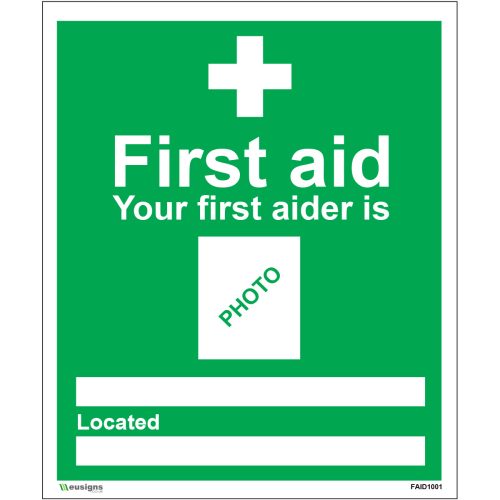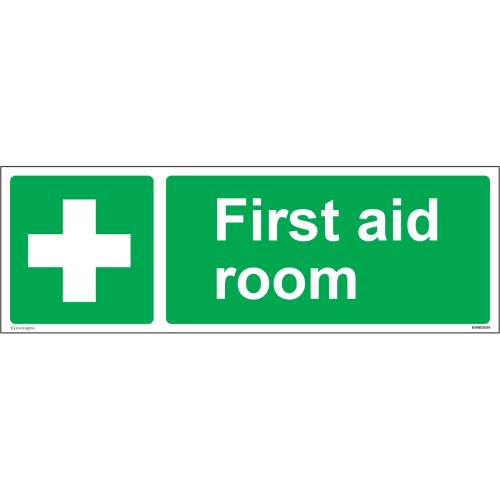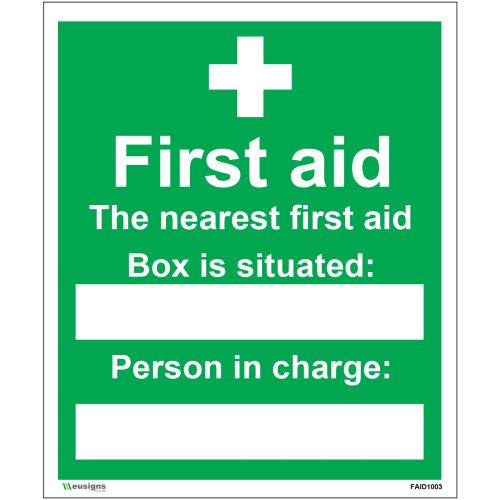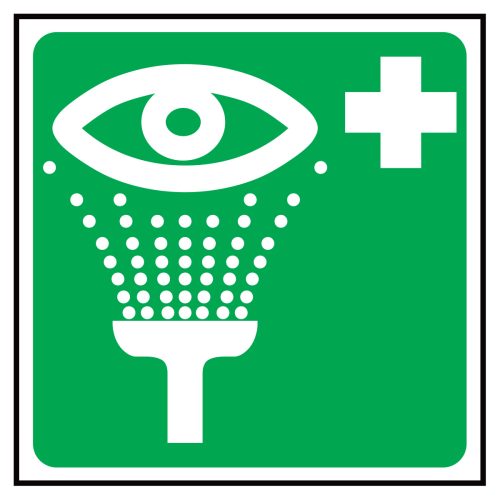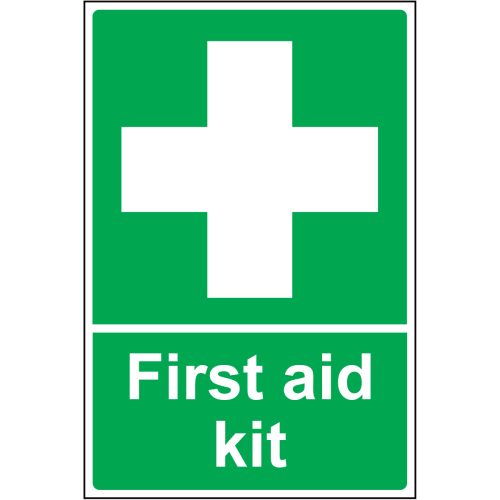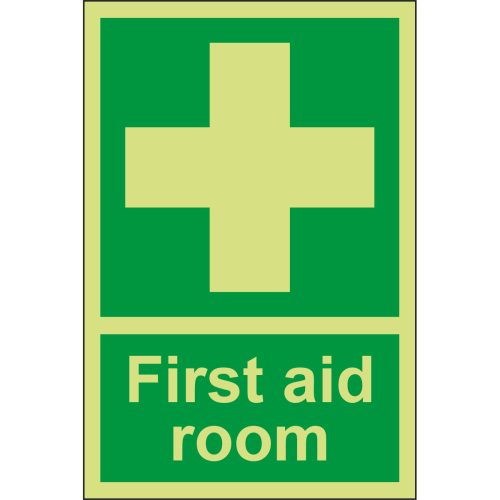Product Categories
- Health and Safety Signs
- First Aid Signs
- Construction Signs
- Warning Signs
- Footpath Signs
- Combination Safety Signs
- Protective Equipment Signs
- Office Signs
- Social Distancing Essentials
- CCTV in Operation Signs
- Information Signs
- Garage Signs
- Health & Safety Posters
- Door Signs
- Health and Safety Stickers
- Custom Printed Banners
- Printed Business Stationery
- Workwear
- Deals
First Aid Room – Portrait
£1.20 – £26.33Price range: £1.20 through £26.33
SKU: FAID2016
First Aid Room – Portrait
All the signs in the First Aid Signs and category conform to the Health & Safety Signs and Signals Regulations – BS 5499-1 and EN ISO 7010. Please contact us at info@eusigns.co.uk for customised size and design requests.
First Aid Room
The First Aid Room sign makes your treatment space obvious the instant someone needs help. Because it follows ISO 7010 safe-condition styling (green field with white cross), people recognise it quickly in noisy, multilingual and high-stress situations. Moreover, the message reads cleanly on doors and narrow wall bays, so staff, visitors and contractors can move with confidence. Choose from A4, A3, 100 × 150 mm, 200 × 300 mm, 300 × 450 mm and 400 × 600 mm formats to suit corridors, receptions and clinical suites. In addition, you can request custom arrows, bilingual legends, corporate colours or reflective faces to match your estate standards, simply email sales@eusigns.co.uk or call 02033752100. Finally, for WD6 postcodes
we offer free local delivery, and you can also collect from our Borehamwood office.
Why a First Aid Room sign improves response time
Under pressure, the eye searches for colour and shape before reading text. Consequently, the green safe-condition panel and the white cross communicate “help here” faster than any sentence. The First Aid Room legend then confirms the destination as people approach the door. Furthermore, when you repeat the symbol along approach routes and across floors, you build a consistent visual language that speeds decision-making during drills and real incidents. As a result, wardens, first aiders and untrained colleagues find the treatment space without hesitation. To complete the journey, pair this product with related categories such as First Aid Signs, Directional First Aid Signs, AED Signs, Safe Condition Signs and Fire Exit Signs. Together, these ranges form a coherent, audit-ready system that people can follow instantly.
Benefits at a glance
- ISO 7010 visual language: green background with white cross for rapid recognition across your estate.
- Door-friendly proportions: portrait options fit single and double doors, cupboards and narrow bays comfortably.
- Durable substrates: Vinyl, PVC, Foamex (3 mm, 5 mm), Aluminium Composite (3 mm, 5 mm, 10 mm), 10 mm Foamex, anti-scratch vinyl and Glow in the Dark on request.
- Hygiene-ready finishes: matte or anti-graffiti laminate for routine cleaning and low glare under bright lighting.
- Estate consistency: matches our First Aid Box Signs and other safe-condition products for unified wayfinding.
UK rules and standards the First Aid Room sign supports
Employers must provide “adequate and appropriate” first-aid equipment, facilities and personnel under the Health and Safety (First-Aid) Regulations 1981. Meanwhile, the Health and Safety (Safety Signs and Signals) Regulations 1996 implement EU Directive 92/58/EEC, aligning the UK with standardised safety colours, shapes and symbols. In practice, a First Aid Room panel that uses the ISO 7010 first-aid cross (E003) and a green safe-condition background fulfils those expectations for visual communication. Although signage alone does not equal compliance, it supports your first-aid needs assessment, your induction process and your emergency drills. For authoritative legal context on emergency arrangements and signage within wider life-safety duties, review the UK government’s guidance on workplace fire safety at GOV.UK – Fire safety in the workplace. Because signage, plans and training work together, you should verify that quantities, positions and sizes match your risk profile.
How a first aid door sign fits your plan
Your first-aid needs assessment identifies the room, the equipment and the personnel; the sign makes that plan obvious to everyone. Place the First Aid Room legend at a consistent eye height (typically 1.5–1.7 m to centre), check that door furniture does not intrude, and repeat the symbol at the last decision point before the room. Additionally, where rooms sit around a corner, install a directional variant so the route remains unbroken. Importantly, keep the field of view free from noticeboard clutter, temporary prints and leaflets that compete for attention. Finally, after refurbishments or layout changes, walk the route again and adjust positions to maintain clear sightlines.
Materials and finishes for a first aid treatment room sign
Different spaces demand different substrates; therefore we offer practical choices that balance cost, lifespan and hygiene. Vinyl adheres neatly to smooth, sealed doors and cupboards; PVC provides economical rigidity for offices and schools; Foamex (3 mm or 5 mm) adds impact resistance in busy corridors; Aluminium Composite (3 mm, 5 mm or 10 mm) delivers premium flatness and long-term stability in public buildings. Moreover, anti-scratch vinyl improves durability in high-touch areas, while Glow in the Dark faces assist legibility during power loss. If your specification calls for specialist thicknesses, reflective faces or a bespoke colour match, email sales@eusigns.co.uk or call 02033752100 and we’ll provide a fast proof.
Finish options that stay readable
Glare hides information precisely when you need clarity. Consequently, we recommend matte or anti-graffiti laminate for the First Aid Room sign wherever lighting is strong or variable. These finishes resist routine cleaning, support hygiene programmes and keep legibility high in glass-rich lobbies, bright corridors and clinical suites. Additionally, radius corners and pre-drilled holes are available for fast, tidy installation on panels or rails.
Installation guidance that saves time
For self-adhesive vinyl, clean and degrease the door, hinge the panel with low-tack tape, peel the liner and squeegee from the centre outward. For rigid boards, use high-bond tape on flush doors or screws with caps where drilling is acceptable. Next, step back to the longest approach and confirm that the First Aid Room legend sits level, unobstructed and free from glare. Because consistency builds recognition, repeat the mounting height across floors and buildings. Finally, add the sign to your inspection schedule so you can replace any panel that becomes faded, cracked or obscured by other notices.
Integrate with your wider emergency signage
- Signage works best as a system. Therefore, combine the First Aid Room marker with complementary products: use
First Aid Box Signs - to label cupboards and trolleys; add Directional First Aid Signs
- along corridors; identify defibrillators with AED Signs;
- standardise green messages with Safe Condition Signs;
- and support evacuation using Fire Exit Signs.
Because the colours and symbols align, people can follow the route from incident to treatment and then out to assembly points without confusion.
Sizing the ISO 7010 first aid sign for clear viewing
Although lighting, sightlines and door geometry influence legibility, you can choose a suitable format by matching the panel to your viewing distance and corridor width. As a simple rule, aim for generous symbol height and keep the green field clear of competing notices. If you add secondary wording, such as room names or access instructions, select the next size up so the cross remains dominant and the text remains readable. The table below shows typical use-cases for each of our standard sizes, together with indicative viewing distances for indoor environments.
How to choose the right size
| Standard size | Typical use | Suggested viewing distance* |
|---|---|---|
| 100 × 150 mm | Compact doors, cupboards, secondary confirmations on approach | Up to ~8–10 m |
| 200 × 300 mm | Standard office/classroom doors, medium corridors | Up to ~12–15 m |
| 300 × 450 mm | Wide doors, high-traffic junctions, longer internal sightlines | Up to ~18–22 m |
| 400 × 600 mm | Large lobbies, open-plan floors, long straight corridors | Up to ~25–30 m |
| A4 (portrait) | Door panels where space is limited but clarity is required | Comparable to 200 × 300 mm |
| A3 (portrait) | Doors and walls in busy corridors or mixed-use buildings | Comparable to 300 × 450 mm |
*Distances are guidance only. Increase size or repeat the sign where lighting, obstructions or glare reduce legibility.
First aid room marker: maintenance, audits and lifecycle
Because the First Aid Room legend forms part of your life-safety communication, include it in routine inspections. Confirm that the door sign remains clean, firmly fixed and unobstructed; remove ad-hoc notices that creep into the same field of view; and replace panels that become scuffed or faded. Additionally, after refurbishments or space-planning changes, walk the route and reposition markers so they remain visible from the longest approach. Over time, a consistent, clutter-free scheme reduces incident confusion and supports both internal audits and external assessments.
Customisation, delivery and collection
Every site is different, so we offer tailored options on request: arrows, bilingual legends, logo lock-ups, reflective faces, oversize panels, and specific thicknesses for door rails or recessed frames. Send your brief to sales@eusigns.co.uk or call 02033752100; we’ll return artwork promptly. To keep projects moving, we provide free local delivery for WD6 and free collection from our Borehamwood office. For multi-site rollouts, we can kit by building or floor, label cartons by location and include quick install guides.
Materials summary for specifiers
Select from:
- Vinyl
- PVC
- Foamex 3 mm, 5 mm
- Aluminium Composite 3 mm
Aluminium Composite 5 mm, 10 mm, Foamex 10 mm, anti-scratch vinyl and Glow in the Dark options also available. All faces are printed for high contrast and easy cleaning.
If you maintain an existing standard, we can match colour values and typography precisely so the First Aid Room panel drops into your design manual without friction.
Need a different size, bilingual text or your logo The layout can be adjusted while maintaining legibility. We manufacture in the UK and keep your specification on file for repeat orders.
Featured Products:
Related products
From: £1.20
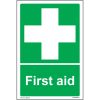
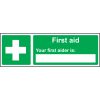
From: £2.50
